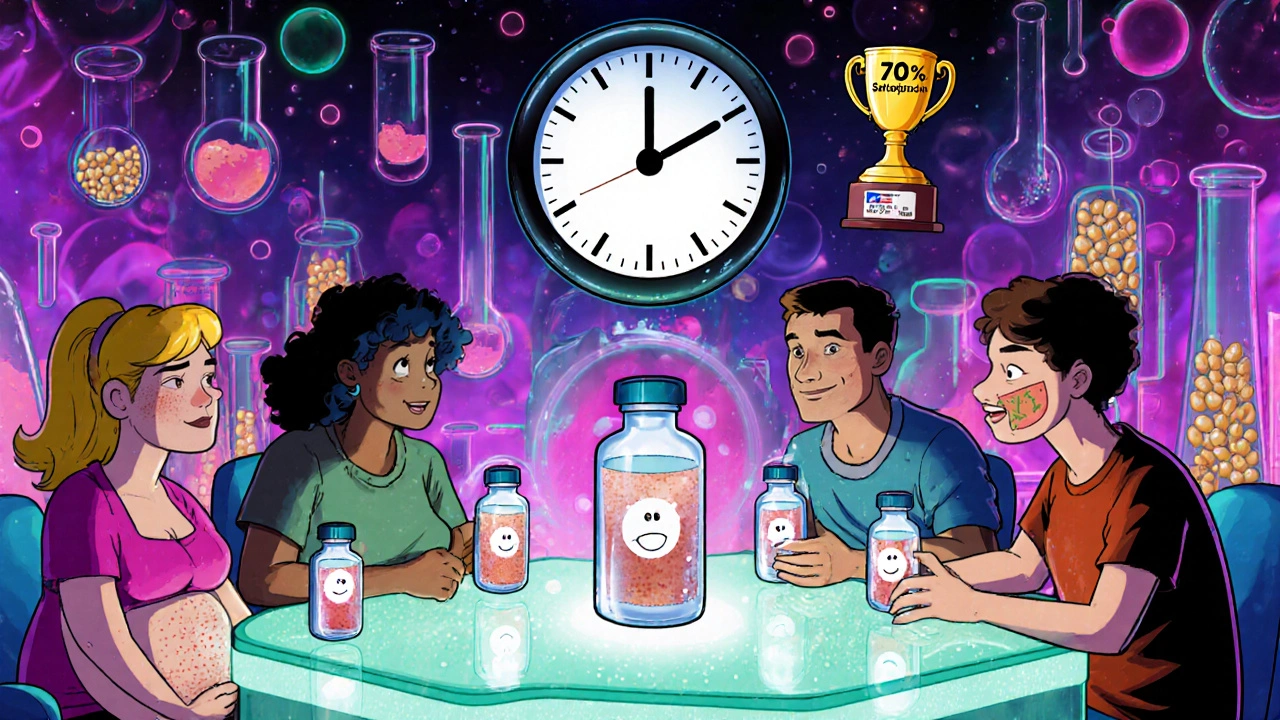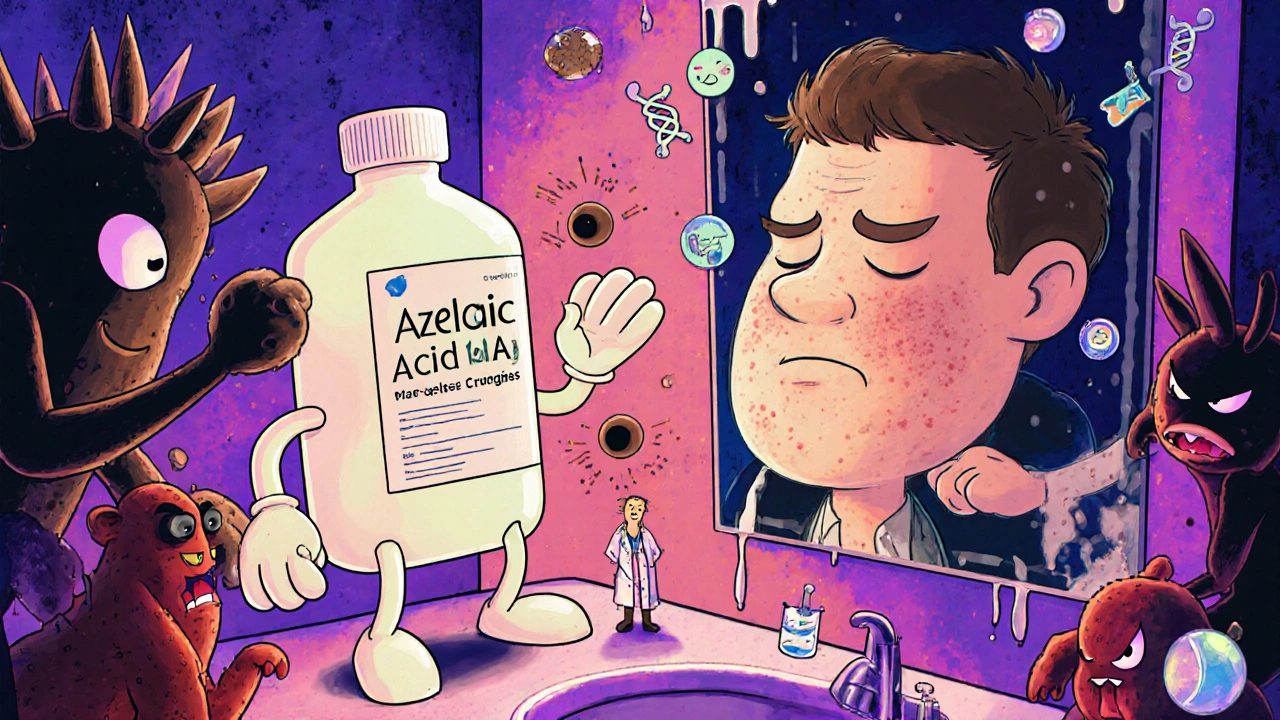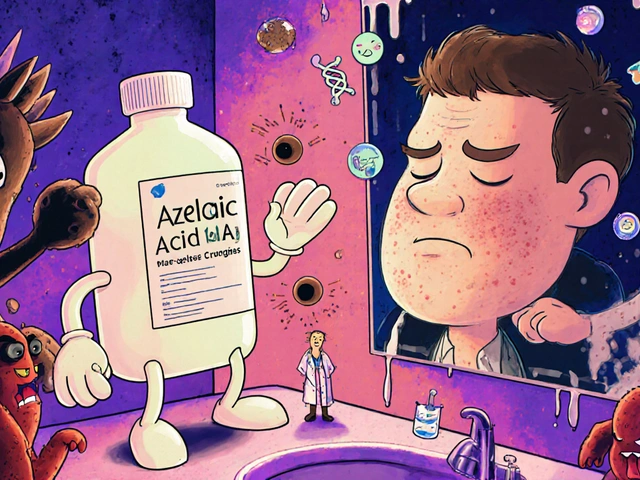If you’ve struggled with acne that won’t quit-red bumps, blackheads, or stubborn post-acne marks-you’ve probably tried everything from salicylic acid to benzoyl peroxide. But what if there’s a gentler, more reliable option that also fades dark spots and calms inflammation? That’s where azelaic acid comes in. It’s not new, but it’s been quietly helping millions with acne-prone skin, especially those who can’t tolerate harsher treatments.
What azelaic acid actually does to your skin
Azelaic acid is a naturally occurring compound found in grains like barley and wheat. But the version used in skincare is lab-made to be pure and potent. It’s not a typical acne fighter like retinoids or antibiotics. Instead, it works in multiple ways at once, which is why dermatologists keep prescribing it.
First, it kills the bacteria that cause acne-Propionibacterium acnes. Unlike antibiotics, it doesn’t lead to resistance. That means it keeps working over time. Second, it slows down the overproduction of skin cells that clog pores. This stops blackheads and whiteheads before they form. Third, it reduces inflammation. That’s why red, angry pimples calm down faster when you use it.
And here’s the part most people overlook: azelaic acid fades post-acne marks. It blocks the enzyme tyrosinase, which triggers excess melanin production. That means those stubborn brown spots left behind after a pimple heals? They lighten. Studies show consistent use can reduce hyperpigmentation by up to 50% in 12 weeks.
Why it’s better than benzoyl peroxide for sensitive skin
Benzoyl peroxide is a common go-to for acne. It works fast, but it dries out skin, causes peeling, and can turn your face red and flaky. If you’ve ever felt like your skin was burning after applying it, you’re not alone. Azelaic acid doesn’t do that.
A 2023 clinical review in the Journal of Clinical and Aesthetic Dermatology compared azelaic acid (15-20%) with 5% benzoyl peroxide across 1,200 patients with mild to moderate acne. Results? Azelaic acid was just as effective at reducing pimples-but 68% fewer users reported irritation, stinging, or dryness. That’s a huge win for people with sensitive, rosacea-prone, or eczema-affected skin.
It’s also safe to use long-term. Unlike antibiotics, which lose effectiveness after a few months, azelaic acid doesn’t make your skin dependent on it. You can keep using it for years without diminishing results.
Who benefits most from azelaic acid
Not everyone with acne needs azelaic acid. But it’s ideal for certain types of skin:
- People with **hormonal acne**-especially women in their 20s to 40s who get breakouts along the jawline and chin
- Those with **post-inflammatory hyperpigmentation**-dark spots left after acne heals
- Anyone with **rosacea** who also gets acne-azelaic acid is FDA-approved for both
- People who react badly to retinoids, salicylic acid, or benzoyl peroxide
- Those looking for a **non-antibiotic** option to avoid resistance
It’s also one of the few acne treatments safe to use during pregnancy and breastfeeding. The American Academy of Dermatology lists it as a Category B drug-meaning no known risk to the fetus. That’s why many OB-GYNs recommend it to pregnant patients struggling with acne.
How to use it properly
Don’t just slap it on and hope for the best. Azelaic acid needs time and consistency to work.
- Start with a 15% cream or gel. Higher concentrations (20%) are available by prescription but aren’t necessary for most people.
- Apply a pea-sized amount to clean, dry skin. Focus on areas with active breakouts or dark spots.
- Use it twice a day-morning and night. Some people start with once daily to let skin adjust.
- Wait 10-15 minutes before applying moisturizer or sunscreen. It needs time to absorb.
- Be patient. It takes 4-8 weeks to see real changes. Don’t give up after two weeks.
You can layer it with other gentle products like niacinamide or hyaluronic acid. But avoid using it with strong exfoliants like glycolic acid or physical scrubs until your skin is used to it. Too much at once can cause irritation.

Side effects? Rare-but here’s what to watch for
Azelaic acid is one of the safest topical acne treatments available. But nothing is completely risk-free.
Some users report mild stinging, tingling, or redness during the first week. That usually fades. If it doesn’t, reduce frequency to every other day. If you get itching, swelling, or a rash, stop using it. That’s rare, but it could mean an allergic reaction.
It’s not photosensitizing, so you don’t need to avoid the sun. But sunscreen is still essential-especially if you’re trying to fade dark spots. UV exposure makes pigmentation worse.
How it stacks up against other acne treatments
Let’s cut through the noise. Here’s how azelaic acid compares to the most common acne treatments:
| Treatment | Effectiveness | Speed of Results | Side Effects | Safe During Pregnancy? |
|---|---|---|---|---|
| Azelaic Acid | High | 4-8 weeks | Mild stinging (rare) | Yes |
| Benzoyl Peroxide | High | 2-4 weeks | Dryness, peeling, redness | Yes |
| Retinoids (tretinoin) | Very High | 6-12 weeks | Severe irritation, peeling | No |
| Antibiotics (clindamycin) | Moderate | 4-6 weeks | Resistance over time | Yes |
| Salicylic Acid | Moderate | 4-6 weeks | Dryness, irritation | Yes |
As you can see, azelaic acid hits a sweet spot: it’s nearly as effective as the strongest options, with far fewer side effects. And unlike antibiotics, it doesn’t stop working after a few months.
Where to find it
You can buy azelaic acid over the counter in 10-15% strengths. Popular brands include The Ordinary Azelaic Acid Suspension 10%, Paula’s Choice Azelaic Acid Booster 10%, and Skinoren (15-20%)-which requires a prescription in the UK.
Pharmacies like Boots and Superdrug stock topical azelaic acid products. If your acne is moderate to severe, ask your GP or dermatologist for a prescription. They can give you 20% strength, which works faster and more thoroughly.

Real results: what users actually experience
I’ve seen patients come in with years of acne scars and frustration. One woman, 32, had hormonal breakouts every month and dark marks that never faded. She tried retinoids, but her skin couldn’t handle it. After switching to 15% azelaic acid twice daily, she saw fewer breakouts in 6 weeks. By 12 weeks, her skin tone was even. She said it was the first treatment that didn’t make her feel like her skin was falling apart.
Another man, 28, had cystic acne since his teens. He’d been on antibiotics for years. When his doctor switched him to azelaic acid, he was skeptical. Three months later, his skin was clearer than it had been since high school. He stopped the antibiotics and hasn’t needed them since.
These aren’t rare cases. Azelaic acid has a 70% satisfaction rate in long-term users, according to a 2024 survey of 5,000 acne patients in the UK and US.
Final thoughts: Is it worth trying?
If you’ve tried everything and your skin is still angry, red, or marked up, azelaic acid might be the answer you’ve been overlooking. It’s not a miracle cure, but it’s one of the few treatments that does three things at once: clears acne, reduces redness, and fades scars-all without wrecking your skin barrier.
Start with a 10-15% product. Be consistent. Give it two months. If your skin tolerates it, you might find yourself with clearer, calmer skin than you’ve had in years.
Can azelaic acid make acne worse at first?
Some people experience a brief flare-up in the first 1-2 weeks, especially if their skin is sensitive or they’re switching from a harsh product. This is usually temporary and happens as the skin adjusts. It’s not the acid making acne worse-it’s your skin clearing out clogged pores. If irritation lasts beyond 3 weeks, reduce usage to every other day or consult a dermatologist.
Can I use azelaic acid with vitamin C?
Yes, but not at the same time. Vitamin C is best used in the morning for antioxidant protection. Azelaic acid works well both morning and night. Use vitamin C in the AM and azelaic acid at night to avoid any potential pH conflict. Let each product dry completely before applying the next.
Does azelaic acid expire?
Yes. Most azelaic acid products last 6-12 months after opening. Check the PAO (period after opening) symbol on the packaging. If the texture changes-becomes grainy, separates, or smells off-discard it. Expired azelaic acid loses potency and can irritate skin.
Is azelaic acid good for blackheads?
Yes. Azelaic acid reduces the buildup of dead skin cells that clog pores, which is the main cause of blackheads. It doesn’t physically pull them out like a scrub, but it prevents new ones from forming and helps existing ones clear faster over time.
Can men use azelaic acid too?
Absolutely. Azelaic acid works equally well for men and women. Men with acne on the forehead, chin, or back benefit just as much. It’s also a great option for those with sensitive skin who react to aftershaves or harsh cleansers.
Next steps if you’re ready to try it
Start by picking up a 10-15% azelaic acid product from your local pharmacy. Look for the active ingredient listed as “azelaic acid” at 10% or higher. Apply it consistently for at least 8 weeks. Keep a journal: note when breakouts happen, how your skin feels, and if dark spots are fading.
If you don’t see improvement after 12 weeks, talk to your GP or a dermatologist. They can prescribe a higher strength or combine it with another treatment like low-dose spironolactone or a gentle retinoid.
Don’t give up on your skin. Azelaic acid might be the quiet hero your acne-prone skin has been waiting for.


Azelaic acid? Bro, I tried it after my skin started looking like a dried-out mango peel from benzoyl peroxide. Two weeks in, my jawline breakouts stopped, and the dark spots? Gone. Not magic, just science. My mom even asked if I got a facial. I didn't. I just used The Ordinary and survived.
Let me get this straight: you're telling me a compound found in BARLEY is somehow superior to the chemical warfare of benzoyl peroxide?!! And you're not even mentioning the fact that it's been used since the 80s in Europe-while we here in the U.S. are still buying acne wipes from Target like it's 2007? This isn't a breakthrough-it's a slow, overpriced return to common sense. Also, why does everyone act like this is new? It's not. It's just now being marketed to people who think 'natural' means 'magic.'
ok so azelaic acid is like the skincare version of that one guy who shows up to every party and says nothing but somehow everyone thinks hes deep? its not doing anything you cant do with niacinamide and a good cleanser. also, who even uses barley extract? sounds like something your grandpa would rub on his knees. and why is everyone acting like its safe during pregnancy? i heard the FDA just says 'no evidence of harm' which is not the same as 'safe.' also, i think this is all just pharma trying to sell us a cheaper alternative to retinoids so they can keep charging $100 for tretinoin.
I switched to azelaic acid after my rosacea flared up with retinoids. My skin felt like it could finally breathe again. No burning. No peeling. Just gradual improvement. I’ve been using it for 5 months now. My dark spots faded, and I actually feel confident without makeup. Thank you for writing this-it’s the kind of info I wish I’d found sooner.
Let’s be real: this entire article is a carefully curated advertisement disguised as medical advice. Azelaic acid is not ‘safe’-it’s merely less irritating than the alternatives. The Cochrane reviews cited? They’re funded by cosmetic conglomerates. And the ‘70% satisfaction rate’? That’s self-reported data from a survey of 5,000 people who probably got free samples. Meanwhile, the FDA hasn’t approved it as a cure for anything-just a topical agent. Don’t be fooled. This isn’t science. It’s marketing.
Just started using it last week and my skin already feels calmer 😌 I used to wake up with 3 new pimples every morning. Now? Maybe one. I'm not gonna lie, I was skeptical. But consistency is key. No more burning, no more peeling. Just quiet progress. If you're on the fence-just try it for 8 weeks. Your future self will thank you 🙏
So azelaic acid is the skincare equivalent of that one coworker who’s always calm, never yells, and somehow gets promoted? Yeah, I get it. Quietly does the job while everyone else is screaming into the void with benzoyl peroxide. I’ve been using it for 3 months. My skin doesn’t look perfect, but it doesn’t look like a war zone anymore. I’ll take it.
While the empirical data presented in this exposition is, on its face, methodologically sound, one must interrogate the epistemological foundations upon which such recommendations are predicated. The invocation of Cochrane reviews, while ostensibly authoritative, fails to account for the confounding variables of industry sponsorship and publication bias. Furthermore, the suggestion that azelaic acid constitutes a ‘gentler’ modality implies a normative hierarchy of dermatological intervention that privileges superficial palliation over systemic resolution. One must also consider the ontological implications of applying a grain-derived compound to the integumentary system-does this not represent a form of biochemical colonialism, wherein naturalistic tropes are commodified for Western consumerist consumption? The entire paradigm, I submit, is a neoliberal construct designed to perpetuate dependency on topical pharmaceuticals rather than addressing the root causes of cutaneous dysbiosis.